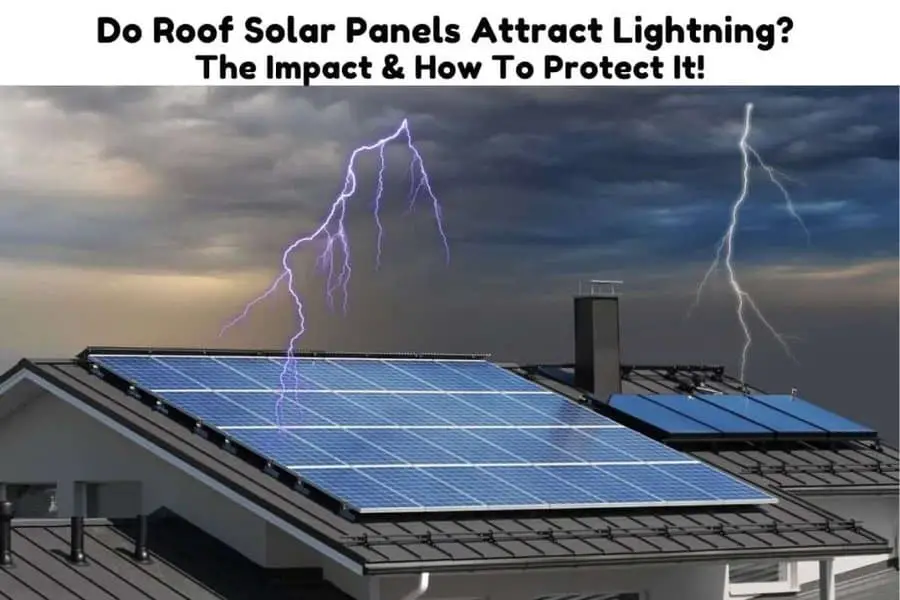Solar panels are an expensive investment. A complete solar system averages anywhere between $16,000 to $35,000 so naturally, you would want to protect your investment.
As they are installed outdoors solar panels are at risk from weather elements like hailstorms, heat, and thunderstorms. Then there is lightning. Should you be worried about lightning strikes if you own solar panels?
According to the National Fire Protection Association (NFPA), fires started by lightning strikes caused over $450 million worth of property damage between 2007-2011 (the latest data available).
Most people believe solar panels attract lightning because they have an electrical current but this is simply not true. Solar panels and their metal frames do not attract lightning.
On a side note! If you’re in need of a reliable and high-performance portable solar panel, We strongly recommend the Jackery SolarSaga 100W Portable Solar Panel (Amazon Link).
With a high conversion efficiency and foldable design, this solar panel is easy to transport and set up, making it perfect for outdoor activities like camping, hiking, and RV trips.

The US solar cell technology used in this panel ensures that you get the most efficient and reliable solar charging possible.
There is also a 60W option that is more affordable (Amazon Link)
Neither the solar panels, the racking, or any of the equipment in a solar system attract lightning as the metal used in solar panels does not attract lightning.
But what happens if lightning does hit a solar panel? That is the question we’ll answer in this article. We will cover how resistant solar panels are to lightning strikes, how you can protect your solar panels, and what happens when lightning comes through the roof of a house.

What Happens if Lightning Hits a Solar Panel?
Solar panels will get badly damaged if struck by lightning. Not only will the solar panels be damaged but so too will the other components in the system. Lightning is five times hotter than the sun.
Lightning strikes can happen in one of two ways. It can either be direct or indirect.
- A direct lightning strike will melt the solar panels and create a high current in the system, overheating and damaging the whole system. Fortunately, direct strikes are rare but they cause more damage than indirect strikes.
- Indirect lightning strikes are more common. In an indirect strike, an electromagnetic induction creates a high voltage in the home and solar system. The voltage spreads through the wiring damaging the solar system components and anything connected to it.
Can Lightning Charge a Solar Panel?
Lightning cannot charge a solar panel. Energy in a solar panel is produced through a photovoltaic effect. The solar panels absorb light which they convert into electricity. Lightning on the other hand is static electricity discharged from a thundercloud.
What attracts lightning?
Again, neither the solar panels, the racking, or any of the equipment in a solar system attract lightning. A common misconception is that the metal in a solar panel attracts lightning. Metal, whether in a solar panel or elsewhere does not attract lightning.
Metal only conducts electricity in a lightning strike. Being an electrical conductor does not attract lightning. Lightning can strike trees, mountains, and even oceans. The things that attract lightning are tall or isolated structures. (Source)
Are Solar Panels Resistant to Lightning?
Solar panels are not resistant to lightning. A solar panel struck by lightning will experience severe damage due to the excessive heat and electrical charge in a lightning bolt.
Lightning has as much as 10 billion watts of energy and a temperature of about 30,000°C. At 3990°C Tantalum Hafnium Carbide Alloy has the highest melting point of any material on Earth. Solar panels are designed to absorb 1,300 watts of energy at a temperature of no more than 25°C. (Source)
Lightning carries too much energy and heat and will destroy solar panels along with any inverter or battery connected to them. Even the appliances connected to the system are likely to suffer damage. That is why you want to take steps to protect your solar system from a lightning strike. But how do you do this?
How Can You Protect Your Solar System from Lightning? (Methods Listed)
A solar system can be protected from lightning by diverting the lightning currents away from the system. One way to do this is by using a lightning protection system. A lightning protection system creates a low-resistance path that diverts lightning currents around your solar panels. The system consists of lightning rods, grounding cables, and surge protectors.
That is one of several ways you can protect a solar system. Here are a few others.
Grounding
Grounding diverts the lightning from your solar panels to the ground. This is a low-tech method more suited for areas that are not very lightning prone. It is a low-tech method because it does not use additional equipment besides grounding cables.
In terms of this method, the solar system is connected to grounding cables made from aluminum or copper. These wires are then dug into the ground. When lightning strikes, the current is channeled into the wires away from the system.
In some cases, a lightning arrestor is used as well. Lightning arrestors are designed to protect against direct strikes.
On a side note, check out you can Use Solid Wire For Solar Panels? (A Brief Solar Panel Wire Guide)
Conducting rods
These are lightning rods designed to conduct the current from direct lightning strikes. They do not attract lightning; they just give it somewhere to go. To that effect, lightning rods are made highly resistant and conductive. Lightning rods are connected to grounding cables and together they divert current from a system and into the ground.
Surge protectors
Surge protectors protect the internal components of a solar system as well as the appliances connected to the system. Surge protectors are built into the AC distribution box of a solar system as well as inverters.
These are the primary ways in which you can protect solar panels against both direct and indirect lightning strikes. Even though lightning strikes may be rare, it is worth considering having a protection system as a precautionary measure.
Can Lightning Come Through the Roof of A House?
Lightning can come through the roof and spread through a house. Lightning is an electrostatic discharge that seeks the path of least resistance from a cloud to the ground. Houses have many potential routes for lightning to use to get to the ground. This includes anything conductive like water piping or wiring from phones or electric cables.
The path lightning uses does not need to be conductive, however. Lightning will use the most convenient path it can find. This might mean connecting to your power lines before it jumps to your water pipes which are typically better grounded.
Lightning presents three main risks to an unprotected house.
- Fire is the most likely thing to happen in a lightning strike.
- A power surge. If lightning goes through your electrical wiring, every appliance that is not surge-protected will be damaged.
- Shock waves from a lightning strike are an explosive force that can tear a home apart. (Source)
